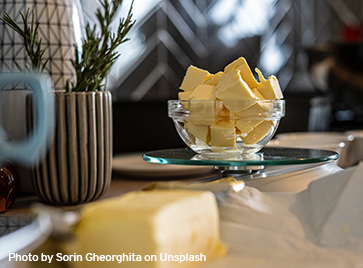Fat doesn’t make you fat. Chronically high insulin levels make you fat.
Fat is delicious. It’s is the vehicle for flavour in our food. Food that is fat-free or low-fat tastes like cardboard which is why food manufacturers have to add loads of sugar, artificial flavours or worst of all, artificial sugar to make them palatable.
Here’s what Dr Willett of Harvard writes:
”Diets high in fat do not account for the high prevalence of excess body fat in Western countries; reductions in the percentage of energy from fat will have no important benefits and could further exacerbate this problem. The emphasis on total fat reduction has been a serious distraction in efforts to control obesity and improve health in general.” Reference here
Fats keep us satiated; boost the immune system, lower inflammation, protect our brain and help regulate hormone production.
But before you go clicking your heels for a bucket of KFC, let me say that not all fats are created equal. As healthy as some fats are, others could be contributing to your inflammation and heart disease.
Food manufacturers will have us believe that because something is labelled all vegetable it’s considered healthy.
Squeezing oil from non oily vegetables requires a surprising amount of heavy duty processing: pressing, solvent extraction, refining, de-gumming, bleaching and deodorizing are all necessary to make these oils tasteless and shelf-stable.These highly processed fats do nothing for our health and actually contribute to inflammation.
 How many years was natural, wholesome butter demonized to be replaced by edible plastic aka: margarine? Some folks are still separating the yolk from the egg whites because of a fear of fat or cholesterol.
How many years was natural, wholesome butter demonized to be replaced by edible plastic aka: margarine? Some folks are still separating the yolk from the egg whites because of a fear of fat or cholesterol.
Click here for all the details about my upcoming online info session
Thanks to Dr. Ancel Keys and a study called the Seven Countries Study, we’ve been preached to repeatedly to ride the low-fat wave.
The theory that was proposed as a result of the Seven Countries Study was that dietary fat was directly linked to heart disease.
The problem with this theory was that it was an assumption based on correlations and didn’t take into consideration various factors such as sugar, industrialization or the refining and transformation of food.
The correlations between dietary fat and heart disease have since been dispelled
but it takes time to slow down the speeding bus that was the low-fat movement and I still often come across the same fear today that fat is bad.
Some of the problems with studying food are that:
- Statistical methodology requires elements to be isolated in order to study their effects. No food is ever eaten in isolation. We never just eat a molecule of vitamin A. Food is far more complex than its component parts.
- Not all food is created equal. It isn’t fair to compare an organic, grass-fed, full-fat yogourt to a sugar-laden, artificially-flavoured, low-fat version. Your body will not react the same way even though they’re both labelled yogourt.
- We are all incredibly unique and what feels good for some doesn’t work as well for others. There can never be a perfect diet just like we couldn’t all fit into the same pair of jeans. Some of us need a lot of fat in our diets and some do well with less.
- The context in which the food is eaten will affect how the body processes that food. A healthy salad eaten during a period of high stress may not sit as well in the same person as a piece of pizza eaten in a relaxed state surrounded by friends. It’s not that pizza is healthier but mindset and context matters a lot.
The more I learn, the more I’m convinced that simple is better. Tuning in to our body’s signals and going with the least processed or fiddled-with option is always a better bet than following the latest trend.
I hope you’ll join me for an info session where I discuss my views on food as well as the details on my best prevention tool for gently guiding clients towards healthier diet and lifestyle choices.





 How many years was natural, wholesome butter demonized to be replaced by edible plastic aka: margarine? Some folks are still separating the yolk from the egg whites because of a fear of
How many years was natural, wholesome butter demonized to be replaced by edible plastic aka: margarine? Some folks are still separating the yolk from the egg whites because of a fear of